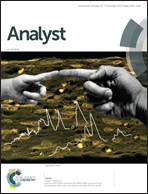Improved identification and quantitation of mature endogenous peptides in the rodent hypothalamus using a rapid conductive sample heating system†
Abstract
Measurement, identification, and quantitation of endogenous peptides in tissue samples by mass spectrometry (MS) contribute to our understanding of the complex molecular mechanisms of numerous biological phenomena. For accurate results, it is essential to arrest the postmortem degradation of ubiquitous proteins in samples prior to performing peptidomic measurements. Doing so ensures that the detection of endogenous peptides, typically present at relatively low levels of abundance, is not overwhelmed by protein degradation products. Heat stabilization has been shown to inactivate the enzymes in tissue samples and minimize the presence of protein degradation products in the subsequent peptide extracts. However, the efficacy of different heat treatments to preserve the integrity of full-length endogenous peptides has not been well documented; prior peptidomic studies of heat stabilization methods have not distinguished between the full-length (mature) and numerous truncated (possible artifacts of sampling) forms of endogenous peptides. We show that thermal sample treatment via rapid conductive heat transfer is effective for detection of mature endogenous peptides in fresh and frozen rodent brain tissues. Freshly isolated tissue processing with the commercial Stabilizor T1 heat stabilization system resulted in the confident identification of 65% more full-length mature neuropeptides compared to widely used sample treatment in a hot water bath. This finding was validated by a follow-up quantitative multiple reaction monitoring MS analysis of select neuropeptides. The rapid conductive heating in partial vacuum provided by the Stabilizor T1 effectively reduces protein degradation and decreases the chemical complexity of the sample, as assessed by determining total protein content. This system enabled the detection, identification, and quantitation of neuropeptides related to 22 prohormones expressed in individual rat hypothalami and suprachiasmatic nuclei.



 Please wait while we load your content...
Please wait while we load your content...